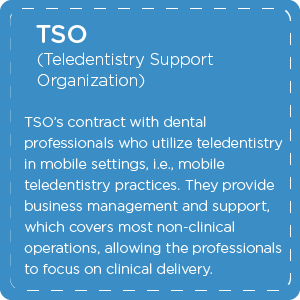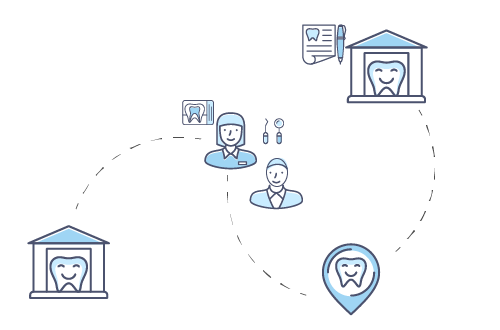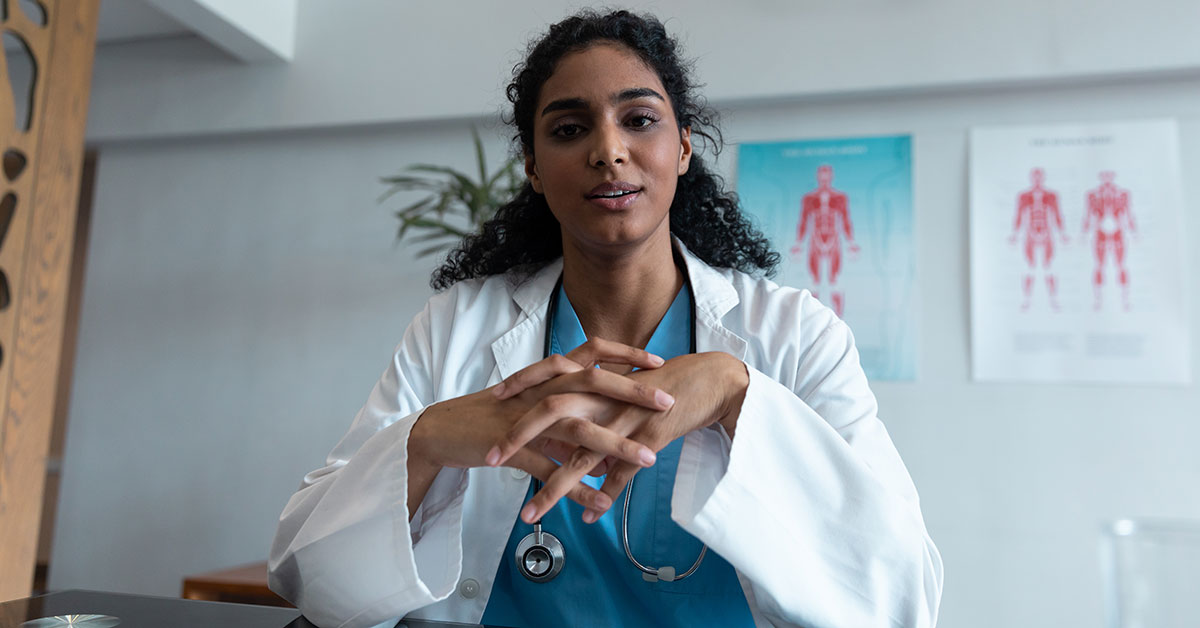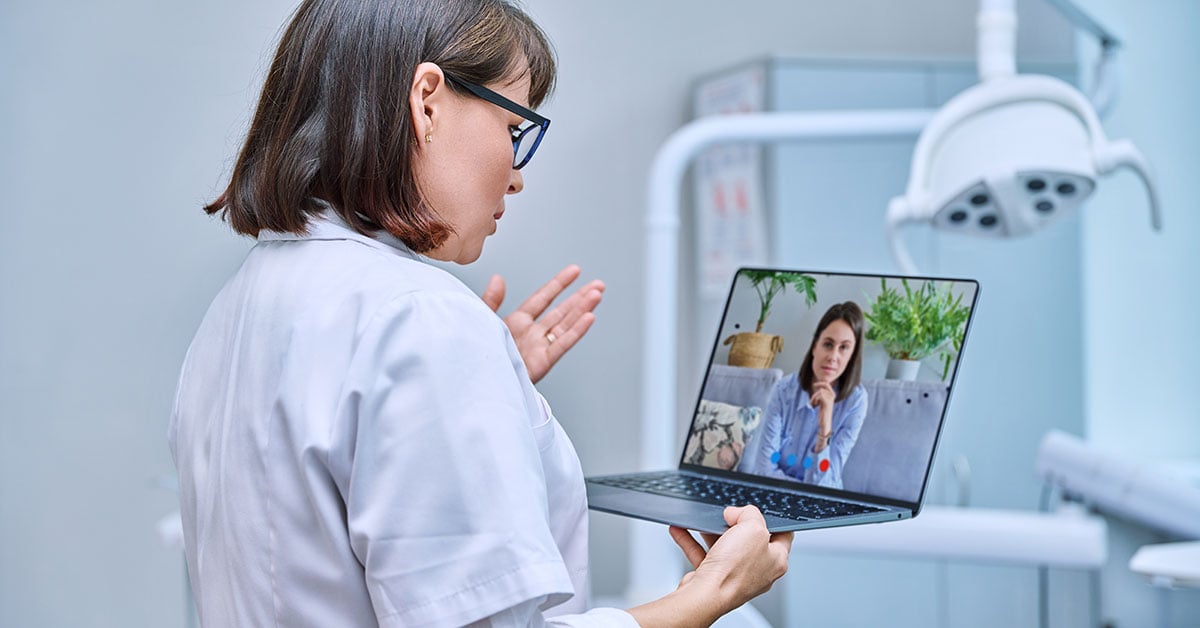Many people in the dental industry are only now looking to teledentistry solutions during these unprecedented times of social distancing, but in fact, there have actually been special types of Dental Support Organizations (DSOs) that have been utilizing Teledentistry for the past few years.
Teledentistry Support Organizations (TSOs) contract with dental professionals who utilize teledentistry in mobile settings, i.e., mobile teledentistry practices. They provide business management and support, which covers most non-clinical operations, allowing the professionals to focus on clinical delivery.
So, what does a mobile teledentistry practice look like?
There are variations of TSOs, but the following is the most common theme. Some combination of dentists, hygienists, and dental assistants travel to offsite locations. The travel can be done in a mobile van, but a less expensive and more flexible approach is often used. The team members travel with a mobile cart that contains a compressor, equipment, and supplies, a collapsible chair, a hand-held x-ray machine, an intraoral camera, and a laptop.
The treatment locations can vary widely. Essentially, they can be setup wherever people congregate, e.g., schools, senior homes, community centers, etc. The most frequently visited locations, though, are in places of employment. Employers welcome the wellness aspect and the decrease in absenteeism. Employees welcome the convenience.
Once on-premise, the team sets-up what are now commonly called pop-up operatories wherever they intend to deliver care. If the location is an office building, the pop-up will usually be setup in an empty office or conference room.

What type of treatment is rendered in a dental pop-up operatory?
Treatment options will vary, but typically, the services performed are preventive, diagnostic, and possibly a few other options, like whitening. State-by-state dental practice acts determine whether a dentist must be on location or not. If so, typically a hygienist will perform the preventive services, and the dentist will do an exam. If the state regulations allow for a hygienist to work independently, the hygienist will perform the preventive services, and diagnostic records will be gathered for later review remotely by a dentist, using our teledentistry software, Teledentix, designed specifically for the TSO and mobile dental model. In either case, if further treatment is recommended, the patient is referred to a bricks-and-mortar office.
What role does the Teledentistry Support Organization play?
The TSO is a professional management company that handles most of the non-clinical tasks necessary to operate a mobile teledentistry practice. While the delivery models may vary, for the sake of illustration, let’s walk through an example of providers delivering care using pop-up clinics at an employer’s office building.
Prior to the first appointment:
- Equipment, instruments, supplies, and laptops need to be researched and purchased
- Equipment, instruments, and supplies need to be stored
- The appropriate software must be chosen
- Marketing and sales activities are required to locate the employers who are willing to participate
- A contract needs to be created which defines the responsibilities of both parties
- Property and casualty insurance need to be purchased
- Contract negotiations need to take place
- Personnel assignments and equipment logistics must be in place
- Transportation must be arranged
- On-premise treatment locations need to be clarified and, perhaps, tested
- Communication to the employees must be arranged, which may include additional marketing materials
- Develop instructional signage for employees
- A mechanism for easy appointment scheduling must be in place
- A mechanism for appointment reminders must be in place
- If insurance is involved, a mechanism to check eligibility and benefits must be in place
- If copays will be collected, a mechanism for collection must be in place
- Treatment offerings must be determined in advance
- Providers need to be trained
- If assistants are utilized, they must be hired and trained
- Create HR policies
- Establish payroll guidelines
- Setup the accounting structure
- Make IT support available
- Frequent communications among all parties – dentists, hygienists, assistant, and location administrator – is required
On the day of the appointment:
- Coordinate transportation to location
- Coordinate setup
- Coordinate signage
- Coordinate announcement
- Test all electrical connections, equipment, and software prior to first patient
- Coordinate patient flow
- Coordinate breakdown
- Coordinate disposal of waste
- Coordinate transportation to return
- If hygienists are working independently, coordinate diagnostic records review by dentist
After the appointment:
- Coordinate the cleaning of equipment and instruments
- Bill and collect insurance
- Facilitate dentist creation of treatment plans, including assuring all plans are completed
- Facilitate follow-up communications with patients
- Facilitate follow-up communications with employers
 Onsite Dental on Pop-Up. Photo courtesy of Onsite Dental
Onsite Dental on Pop-Up. Photo courtesy of Onsite Dental
In other words, by working with a TSO, providers need only show up at the treatment
What is the relationship between the Teledentistry Service Organization and the providers?
Dental providers contract with TSOs to deliver the above services and more. The contract, typically called a Management Services Agreement (MSA) clearly defines the relationship and details the duties of each party. An important part of all MSAs is to make clear that the TSO will not be involved in any aspect of delivery of care or any decisions relating to clinical care. They are simply a management company hired by the providers to manage non-clinical tasks. Compensation to TSOs can vary, but usually it is some percentage of collections.
Since there is no clinical care delivered by the TSO, it can be owned by non-professionals. Nonetheless, they are often founded by a dentist or hygienist, who then hire a professional management team.
TSOs come in all sizes, but the concept of scale is an important component for success. Spreading the cost of professional management over many providers will increase the providers’ profits. Also, the advantages of large group purchasing will decrease expenses.
TSOs are a relatively new sector in the dental industry, but pre-coronavirus, the concept had already caught the attention of employers creating huge demand. Of course, if employers are interested, dental insurance companies will not be far behind. Discussions of incorporating on-premise pop-ups into insurance plans is already underway.
What software do Teledentistry Support Organizations and mobile dental professionals use?
Before the dental industry was buzzing about Teledentistry, TSOs and mobile dental professionals had been using Teledentix to power their operations. Teledentix allows for scheduling across multiple treatment sites, patient forms, video consultations, and remote treatments plans that can all be accessed by both the provider and the TSO.
Teledentix had been proven out as a fully comprehensive teledental solution for years before social distancing. Now that solo practitioners and traditional DSOs alike have began implementing teledentistry programs, Teledentix is ready to meet their needs. Click below to learn more about Teledentix.




